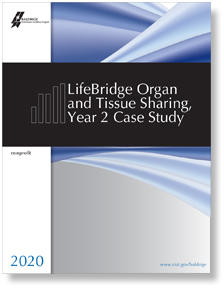
Now available on our website, the 2020 Baldrige Case Study: LifeBridge Organ and Tissue Sharing (LOTS), Year 2 demonstrates how the Baldrige Criteria (part of the Baldrige Excellence Framework: Proven leadership and management practices for high performance) can be applied across seven key areas of an organization’s performance, and how feedback generated from the Criteria can be used for improvement.
Modified from a real Baldrige Award application, LOTS depicts an organization that has re-applied for the Baldrige Award. It features a fictitious, federally designated, organ procurement organization. The case study was used to virtually train the 2020 Malcolm Baldrige National Quality Award Board of Examiners on how a nonprofit organization might use the Baldrige Criteria.
Baldrige master examiners Carlos Ayala, Maureen Baca, Steven Bonk, Alice Lewis, Marci Kenney, John Vinyard, and Eric Malloy reviewed a 2019 Baldrige Award feedback report and suggested updates for this 2020 case study. The fictitious organization has updated many of its processes with improvement cycles; added marketing initiatives to educate and encourage people to register as organ donors, a Baldrige benchmarking project, new processes for innovation and workforce performance management, and community support projects; and created opportunities for more learning and succession planning within the organization. (Note: From 2019 to 2020, the fictitious organization increased its process scoring band from 4 to 5 and results scoring band from 3 to 4.)
The Baldrige Program is very grateful to an actual organ procurement organization that allowed its own Baldrige-based award application to be the basis for this case study. From that real application, names and data were fictionalized, and elements were intentionally edited to be less mature, less beneficial, or missing in order for this case study to be scored lower by a team of examiners than the real application likely would have been scored to provide more training opportunities.
Baldrige case studies have at least three purposes. First, given that actual Baldrige Award applications remain confidential until award-winning organizations approve selected content for public sharing, the case studies are used to train examiners for the Baldrige Program’s annual award process. Second, the case studies serve as sample applications for organizations interested in applying for a Baldrige Award or in writing a whole or partial application as a self-assessment. In addition, the case studies show organizations in every sector how they might use the Criteria questions to assess and improve their performance, even if they are not interested in applying for a Baldrige Award. Case studies are also used by Baldrige-based regional or state award programs that are members of the nonprofit Alliance for Performance Excellence, part of the Baldrige Program’s public-private partnership.
A team of Baldrige master examiners (Lori Kirkland [team leader], Bill Craddock, Janet Johnson, Kay Kendall, Deb Manzo, Jim McCorvey, and Michael Reames) evaluated the case study of the fictitious organization against the Criteria and created a consensus scorebook.
You can learn how LOTS, Year 2, scored in that assessment against the 2019–2020 Baldrige Excellence Framework through the following free, downloadable resources related to the LOTS Case Study:
- The 2020 LifeBridge Organ and Tissue Sharing, Year 2, Consensus Scorebook (Word)
- The 2020 LifeBridge Organ and Tissue Sharing, Year 2, Feedback Report (PDF), which shows the scorebook comments in the format of the reports received by actual Baldrige Award applicants at the end of the annual evaluation process
Beyond learning from best practices and other examples in this case study, organizations that wish to get started with Baldrige-based performance improvement can access sector-specific resources online at “Baldrige by Sector” and basic ideas for how to get started using the Baldrige framework.
Since 1987, the Baldrige Program has produced case studies that describe how fictitious organizations are fulfilling the elements of the excellence framework and continually improving in challenging situations and economies. The case studies rotate sectors to show examples for a variety of organizations using the three versions of the Baldrige Excellence Framework: Business/Nonprofit, Health Care, and Education.
Additional Baldrige case studies are available for free downloading in the Baldrige materials archive.

